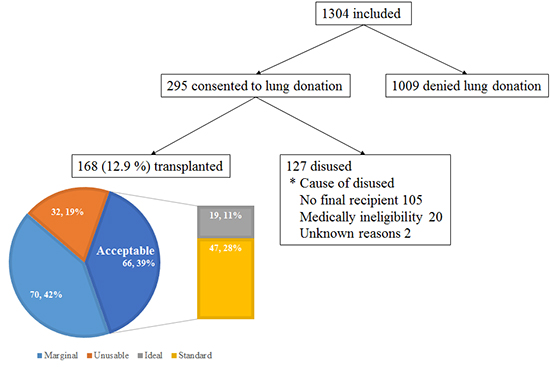2. Paik HC, Haam SJ, Lee DY, Yi GJ, Song SW, Kim YT, Kang CH, Kim KM, Park SI, Jheon SH. The fate of patients on the waiting list for lung transplantation in Korea. Transplant Proc. 2012; 44:865–869.
5. Kim H, Jeon YK, Lee HJ, Kim YT, Chung DH. Clinico-pathological analysis of the lungs from patients with lung transplantation in a single institute in Korea. J Korean Med Sci. 2015; 30:1439–1445.
6. Jhang WK, Park SJ, Lee E, Yang SI, Hong SJ, Seo JH, Kim HY, Park JJ, Yun TJ, Kim HR, et al. The first successful heart-lung transplant in a Korean child with humidifier disinfectant-associated interstitial lung disease. J Korean Med Sci. 2016; 31:817–821.
7. Yeo HJ, Lee S, Yoon SH, Lee SE, Cho WH, Jeon D, Kim YS, Kim D. Extracorporeal life support as a bridge to lung transplantation in patients with acute respiratory failure. Transplant Proc. 2017; 49:1430–1435.
8. Botha P, Fisher AJ, Dark JH. Marginal lung donors: a diminishing margin of safety? Transplantation. 2006; 82:1273–1279.
9. Reyes KG, Mason DP, Thuita L, Nowicki ER, Murthy SC, Pettersson GB, Blackstone EH. Guidelines for donor lung selection: time for revision? Ann Thorac Surg. 2010; 89:1756–1764.
10. Yusen RD, Edwards LB, Kucheryavaya AY, Benden C, Dipchand AI, Goldfarb SB, Levvey BJ, Lund LH, Meiser B, Rossano JW, et al. The Registry of the International Society for Heart and Lung Transplantation: thirty-second official adult lung and heart-lung transplantation report--2015; focus theme: early graft failure. J Heart Lung Transplant. 2015; 34:1264–1277.
13. Jeong JH. Brain and lung: lung injury in patients with brain injury. J Neurocrit Care. 2017; 10:1–6.
14. Faropoulos K, Apostolakis E. Brain death and its influence on the lungs of the donor: how is it prevented? Transplant Proc. 2009; 41:4114–4119.
15. Wood KE, Becker BN, McCartney JG, D'Alessandro AM, Coursin DB. Care of the potential organ donor. N Engl J Med. 2004; 351:2730–2739.
16. Rosendale JD, Chabalewski FL, McBride MA, Garrity ER, Rosengard BR, Delmonico FL, Kauffman HM. Increased transplanted organs from the use of a standardized donor management protocol. Am J Transplant. 2002; 2:761–768.
17. Miñambres E, Pérez-Villares JM, Chico-Fernández M, Zabalegui A, Dueñas-Jurado JM, Misis M, Mosteiro F, Rodriguez-Caravaca G, Coll E. Lung donor treatment protocol in brain dead-donors: a multicenter study. J Heart Lung Transplant. 2015; 34:773–780.
18. Abuanzeh R, Hashmi F, Dimarakis I, Khasati N, Machaal A, Yonan N, Venkateswaran RV. Early donor management increases the retrieval rate of hearts for transplantation in marginal donors. Eur J Cardiothorac Surg. 2015; 47:72–77.
19. NHS Blood and Transplant (US). Donation after brainstem death (DBD): donor optimisation extended care bundle [Internet]. accessed on 16 October 2017. Available at
http://odt.nhs.uk/pdf/dbd_care_bundle.pdf.
20. Mascia L, Pasero D, Slutsky AS, Arguis MJ, Berardino M, Grasso S, Munari M, Boifava S, Cornara G, Della Corte F, et al. Effect of a lung protective strategy for organ donors on eligibility and availability of lungs for transplantation: a randomized controlled trial. JAMA. 2010; 304:2620–2627.
21. Westphal GA, Garcia VD, Souza RL, Franke CA, Vieira KD, Birckholz VR, Machado MC, Almeida ER, Machado FO, Sardinha LA, et al. Guidelines for the assessment and acceptance of potential brain-dead organ donors. Rev Bras Ter Intensiva. 2016; 28:220–255.
22. Schiavon M, Falcoz PE, Santelmo N, Massard G. Does the use of extended criteria donors influence early and long-term results of lung transplantation? Interact Cardiovasc Thorac Surg. 2012; 14:183–187.











 PDF
PDF ePub
ePub Citation
Citation Print
Print




 XML Download
XML Download